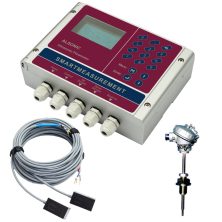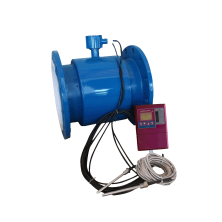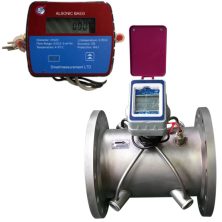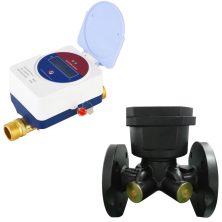Featured Products
Energy Flow Meter Overview
Over the past several decades, efforts to reduce energy usage have been considerable as energy costs and environmental concerns continue to increase exponentially. The incentive for reducing energy consumption is clear – it generates a variety of benefits from an economic standpoint. Energy efficiency leads to reduced energy costs, which enhances a facility, whether it be residential, institutional, or industrial.
One area that presents enormous opportunities for reductions in energy use is heating, ventilation, and air conditioning (HVAC) systems used for homes, apartment buildings, and large institutional buildings such as schools and hospitals. Larger HVAC systems, such as those installed in apartment or condominium developments, are increasingly facing expanded and more stringent regulations, guidelines, and initiatives emphasizing the importance of energy-efficient HVAC systems. HVAC is where the BTU/Energy flowmeter finds its niche – by providing the ability to accurately and reliably monitor both water and energy usage for HVAC systems. The energy flowmeter enables the operator to identify and pinpoint areas within the system that are able to be optimized for greater efficiency and to manage the system for the best overall energy consumption.
Energy meters consist of a flowmeter with temperature sensors and a flow computer. These can be integral or remote-mounted. Smart Measurement offers a variety of Energy meters from fixed ultrasonic technologies with the ALSONIC-BAEG, clamp-on ultrasonic with the ALSONIC-EG, to magnetic technology with the ALMAG-EG.
Choosing the Appropriate Energy/Water Meters
Historically, these types of applications have made use of mechanical flowmeters such as nutating disc or tangential turbine/paddlewheel style devices. These antiquated flow technologies have limited accuracies, subject to wear and tear, rusting, and leakage, and cannot be controlled and monitored in a central office. The newest generation of smart metering solutions consists of non-mechanical technologies primary transit time ultrasonic technologies or electromagnetic technologies, not only are they maintenance-free but also offer real-time knowledge based on a variety of two-way digital communication between facility managers and the flow meter. Digital technology provides real-time information such as flow, temperature, energy, etc., allowing for accurate billing, faster leak detection, and efficient renovation of your distribution network.
Inline Ultrasonic Energy Flow Meters
Inline ultrasonic water meters such as SmartMeasurement ALSONIC-BAWM for hot/cold water and ALSONIC Building Automation-Energy meters or the ALSONIC-BAEG provide a low-cost alternative to mechanical hot water/BTU meters.
The ALSONIC family of water and energy meters employs transit-time ultrasonic flow technology. Moreover, the Alsonic energy meters are combined with two integrated PT1000 RTD temperature sensors for calculating both total and instantaneous energy consumption. Both the water and energy meters are available in sizes from ½” to 1½” with brass and NPT threads (other materials are available upon request) with flanged carbon steel for sizes 2″ and over. The standard version can accommodate operating temperatures of up 95°C (203°F) with optional operation of up to 130°C (266°F) available upon request. These ultrasonic meters meet the standards for residential and commercial utility metering. The alphanumeric LCD displays heat consumption, temperature, flow total, operation time, and flow rate with data storage for up to 18 months of operation. The meter also has a remote readout configurable with CJ/T188 and N1434 BTU/heat meter standards configurable via RS485/Modbus, BACnet, or GSM/GPRS wireless, for integration with any AMR/AMI system.
Advantages:
- Lowest-cost energy flow meter
- May be deployed as a drop-in replacement for some existing how water meters
- Can be used in homes and apartments
- Can be deployed on smaller pipe sizes versus clamp-on ultrasonic
Disadvantages:
- Cannot measure water with more than 1% particles/bubbles
- Higher installation costs than clamp-on ultrasonic meters
- Cannot be used in energy measurement applications where portability is required
- Temperature range of -32-195 °F (0 ~ +90˚C); lower than magnetic energy meters
Clamp-on Ultrasonic Energy Flow Meters
The ALSONIC-EG clamp-on ultrasonic energy meters are extremely useful in situations where a new meter needs to be installed on an existing pipeline or an existing meter needs to be replaced. Older technology meters such as turbines and paddlewheel, as well as newer technology meters like the mag meter, require either inline or insertion-type mounting. This means that either the process must be shut down or the piping where the meter needs to be installed must be isolated to accommodate the installation. Additional labor is required to either cut the pipe and weld flanges for inline installation or to install weld-o-let for insertion-style meters. The clamp-on installation method used for the ultrasonic meter makes all of this additional material and labor unnecessary thereby allowing for significantly lower installation costs. Overall, clamp-on technology offers advantages for a variety of applications including residential and institutional HVAC, thermal storage, power plant, condenser water, chemical feed, and ammonia feed. Moreover, the ALSONIC-EG is available in a portable version called the ALSONIC-PLEG which includes clamp-on temperature sensors that make it suitable for site surveys, or applications where a fixed system is not necessary.
SmartMeasurement’s ALSONIC-EG offers a clamp-on ultrasonic flow meter designed specifically for the unique and challenging needs of the HVAC industry. The accuracy, wide turndown, bi-directional measurement capability, and high level of sensitivity provided by the ALSONIC-EG help to optimize the energy efficiency of most HVAC applications while introducing no pressure drop and avoiding the performance and readability problems that negatively impact the performance of older-technology mechanical thermal energy flowmeters. The ALSONIC-EG‘s analog input capability allows for the calculation of cooling load (kW/ton), coefficient of performance (COP), and energy efficiency ratio (EER). It also serves as a high-precision thermal energy flow meter with 1000 Ohm platinum RTD clamp-on or insertion-type sensors combined with four-wire temperature cables.
Advantages:
- Very low installation costs – transducers clamp onto the pipe
- Capable of measuring flows in very large pipes
- Can be used in portable applications
Disadvantages:
- Limited amount of particles or bubbles (1-2%)
- Accuracies of 1-2%; lower than electromagnetic energy meters
- Temperature range of -22~+230 °F (-30 ~ +110˚C); lower than electromagnetic energy meters
Electromagnetic or Magnetic Energy Flow Meters
SmartMeasurement’ s ALMAG-EG energy flow meters are electromagnetic flowmeters featuring integrated RTD temperature sensor inputs and software that performs the energy consumption calculation and displays the result directly on the instrument’s readout. The magnetic flow measurement technology is suitable for any electrically conductive fluids having conductivities greater than 5 µS/cm. The no-moving-parts design of the electromagnetic flowmeter makes it ideal for replacing older technology BTU/energy meters such as turbine or paddlewheel types. Electromagnetic flow technology offers the best performance for most hot and chilled water applications, including new installations and small line sizes below 24″ (600 mm). For more discussion on magnetic flow meters please go to: Magnetic flow meters
Electromagnetic flow meters provide numerous benefits in HVAC applications such as ease of operation, low maintenance afforded by the no-moving-parts design, superior longevity, and overall lower cost of ownership versus traditional mechanical flow measurement technologies. The ALMAG-EG offers an advantage over ultrasonic meters because it can measure accurately even if entrained particles or bubbles are present in the fluid, which most lower-cost ultrasonic meters are unable to do. Magnetic flowmeters are also more widely used in general industrial energy measurement applications such as chillers, heat exchangers, or situations where higher accuracies are of the utmost importance.
Some advantages and disadvantages of magnetic energy meters are as follows:
Advantages:
- The most accurate flow measurement technique among all energy flow meters; up to ± 0.2% of reading
- Able to measure fluids with particles and bubbles present
- Capable of measurement over a wide range of temperatures; -58-356 °F (-50 ~ +180˚C)
Disadvantages:
- Higher cost than ultrasonic technology
- Higher installation costs versus clamp-on ultrasonic meters
- Cannot be used in energy measurement applications where portability is required
Special Cases
Energy efficiency and pollution controls
Reducing energy costs is great for the environment
Hot and cold-water systems have the potential to consume a tremendous amount of electricity, which in turn can generate a great deal of air pollution. According to an estimate from the American Council for an Energy-Efficient Economy, buildings’ HVAC systems account for more than one-third of energy use and carbon emissions in the United States. Energy flowmeters are the key component that allows operators to measure BTU/energy consumption. Therefore, reducing energy consumption for all types of facilities, including large buildings, shopping centers, and apartments.
Please visit our industrial measurement applications section for more detailed information about where our Water & Energy flow meters have been successfully used.
Request a quote for water & energy flow meters for your application, or contact SmartMeasurement to learn more.
In recent years, energy flow meters offered in the marketplace have had numerous features and updates available. Energy flowmeters are presently available for use by the HVAC industry with features such as non-invasive flow measurement, digital communication protocols such as Modbus and BACNET, integrated data logging, and accuracy grades as high as ± 0.5% of reading.
Flow meters or energy flowmeters demonstrating a high accuracy rate can be deployed as revenue-grade thermal energy meters and may be used to generate billing for energy usage. Sub-metering applications are becoming increasingly popular. These applications are made possible by these newer-technology meters. In sub-metering applications, individual users or tenants within a large residential or commercial building have their energy consumption monitored using an energy flowmeter, and their usage is then billed based on the readings provided by the BTU meter. Learn more information about our ALSONIC-BAEG Economic Flow Meter with BTU Measurement
Key Applications
Water & Energy flowmeters from SmartMeasurement have been successfully installed in a wide variety of industries and applications including:
- Heating ventilation and air Conditioning (HVAC)
- Water utilities
- Facility management for shopping centers and apartment buildings
- AMR (automatic meter reading)
- Billing management systems (BMS)
- Water distribution networks







